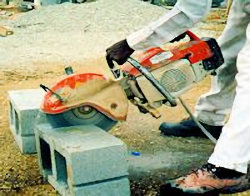Engineering Controls
If you can't eliminate or replace a respiratory hazard, use engineering controls to lower exposures to safe levels.

These controls "engineer" or physically change the work environment, so the air is safe to breathe. Examples of engineering controls include:
- isolating a production process so that the employees are not exposed;
- installing an exhaust hood to remove air contaminants;
- using wet methods (water) to reduce exposure to airborne dust;
- integrating dust collection systems into cutting and grinding equipment.
Administrative Controls and Respiratory Protection
Administrative controls establish programs and policies that require employees to use processes, procedures, and practices to help to limit exposure to hazardous substances. As you can see, the primary strategy is to control behaviors to limit exposure. Some examples of administrative controls related to respiratory protection include:
- requiring employees to use respirators when working with asbestos;
- conducting hands-on training on the use of respirators;
- establishing rules for care and maintenance of respirators;
- mandating medical exams for all employees who will use respirators.
Employees must use respirators for protection from respiratory hazards when engineering controls are not feasible or will not reduce their exposures to safe levels.
Knowledge Check Choose the best answer for the question.
1-5. Integrating dust collection systems into cutting and grinding equipment is an example of which hazard control methods?
You forgot to answer the question!
